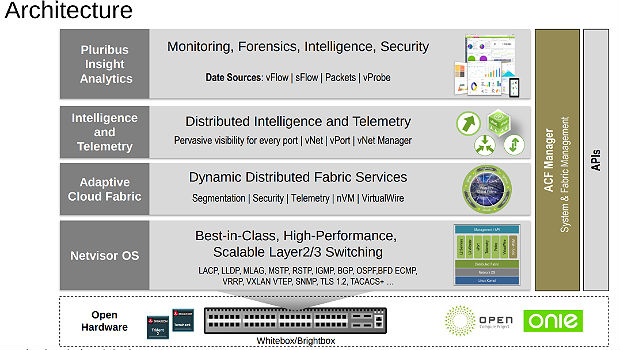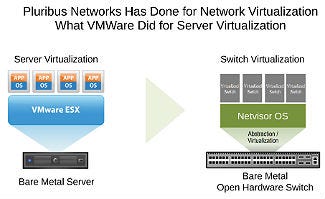Fresh off a $21 million Series E round, the provider reaches out to partners for help rebooting its Adaptive Cloud Fabric vision.
April 25, 2017

 By Kurt Marko
By Kurt Marko
Founded in 2010, Pluribus Networks was an early entrant into the great SDN land grab. At the time, the conventional wisdom held that traditional switches and routers – and their purveyors, namely Cisco – would eventually be replaced by commodity white boxes stuffed with merchant silicon directed by systems running virtualized network control software.
 Eschewing the headlong rush to embrace OpenFlow, Pluribus developed an alternative network control plane, the Virtualization-Centric Fabric (VCF). While it can now emulate an OpenFlow interface, VCF differs in important ways, perhaps most notably by distributing the network controller across multiple servers while maintaining compatibility with legacy Layer 2/Layer 3 switch topologies.
Eschewing the headlong rush to embrace OpenFlow, Pluribus developed an alternative network control plane, the Virtualization-Centric Fabric (VCF). While it can now emulate an OpenFlow interface, VCF differs in important ways, perhaps most notably by distributing the network controller across multiple servers while maintaining compatibility with legacy Layer 2/Layer 3 switch topologies.
OpenFlow hype deflated from euphoria to disillusionment as the market for pure, physical-layer SDN proved to be minuscule outside of large telecoms and hyperscale cloud providers. Still, Pluribus chugged away with its proprietary control fabric and a compatible OS for white-box network switches. The company found success with OEMs like Ericsson, which used Pluribus in its rack-scale converged infrastructure product, and Tibco, which incorporates Pluribus into its enterprise message service appliance.
Although the company has notched a few enterprise wins, including Steelcase, which uses its software as the network backbone for a private cloud, Pluribus has mostly toiled in the shadows, appealing to infrastructure service providers and tech-savvy organizations building distributed big data clusters or other specialized infrastructure.
It’s a niche that Pluribus aims to break free from, with some help from its channel.{ad}
Fresh off a $21 million Series E funding round, Pluribus says it’s tired of being the best networking technology no one ever heard of. It’s rebooting with a new enterprise-focused marketing message and relaunching its network control software as the Adaptive Cloud Fabric, though this week’s announcement of the Pluribus Adaptive Cloud Fabric is less about new features – there are few – and more about a new outreach to a broader enterprise market, particularly those businesses that rely on IT partners for technology advice and implementation.
Carriers, open-source consortiums and big IT vendors have laid the groundwork for SDN and NFV. Demand is there, so what’s stopping widespread use? Complexity, a skills shortage and confusion. Click here for access to our Report, “5 Must-Have Skills for Selling SDN and NFV.” |
Pluribus is using the spring meeting of the Open Networking User Group (ONUG) as the backdrop for its announcement, but partners that follow the software-defined networking market will find little new. Instead, the company is reaching out to those that don’t understand the technology to illustrate what the network version of VMware means. Namely, by virtualizing networking at …
{vpipagebreak}
… the switch layer, Pluribus can:
Create multiple virtual vPorts from physical switch ports.
Create and distribute software switch and routing tables.
Use a distributed control plane that controls network flows across all switches in a cluster, without the need for a separate network controller since control functions are built into the switch OS.
Pluribus VP of marketing Steven Shalita says this week’s announcement is a relaunch of VCF 2.0 along with an update to its Netvisor switch OS. Yes, there are updated speeds and feeds for its OEM’d switches and the notable addition of WAN support that allows the Pluribus virtual fabric to span multiple data centers. However, the real purpose of the PR push is to better explain both the technology and, more importantly, the business value of Pluribus’ technology for organizations building fully virtualized private clouds.
These include:
Support for lower-cost white-box switches that support the Open Network Install Environment (ONIE) or Open Compute Project (OCP) hardware
Network telemetry that links to virtual ports and tracks devices and workloads as they move between physical servers and switches in a virtualized private cloud
Central management and automation, including support for popular orchestration tools like Ansible and vCenter
Standards-based L2/L3 interoperability with traditional switching and routing infrastructure allowing the Pluribus Adaptive Cloud Fabric to be deployed alongside legacy networks
What’s in it for partners?{ad}
Shalita says that Pluribus is expanding both its OEM business and channel, which includes about 30 partners — although many of these are “stealth” partners that don’t promote the relationship due to longstanding and lucrative relationships with large, incumbent network vendors. Although Pluribus will be launching a new channel program in the coming month, Shalita says its existing plan includes the usual incentives (SPIFs) and training. A more interesting benefit is what Shalita calls “pressure-free margin.” Because Pluribus runs on a variety of commodity, open switching hardware, partners can offer customers enticing pricing upfront without the need to aggressively discount from inflated list prices.
“We don’t need a lot of incentive programs,” says Shalita.
In addition, an extensible software architecture means Pluribus enables partners to more easily incorporate other network services, such as managed security, WAN optimization/SD-WAN and network analytics into their portfolios, often through NFV for maximum margins, as we discuss in this report.
Indeed, with WAN support, Pluribus can duplicate many of the intelligent traffic management features of SD-WAN products, another channel favorite. Overall, Shalita says that Pluribus provides partners with a flexible network platform that allows them to create and deliver differentiated services.
Adaptive Cloud Fabric, the new Netvisor 2.5.3 release and Insight Analytics management software are immediately available, with the switch OS sold as either a perpetual license or subscription per switch. Aside fromwhite box, OCP/ONIE-compliant hardware, other supported devices are available from Dell EMC, Accton/Edgecore and Pluribus itself.
Kurt Marko is an IT industry analyst, consultant and regular contributor to a number of technology publications.
Read more about:
AgentsAbout the Author(s)
You May Also Like


